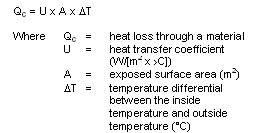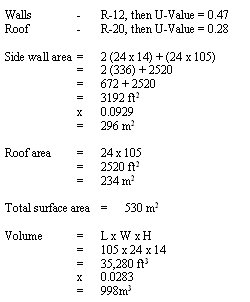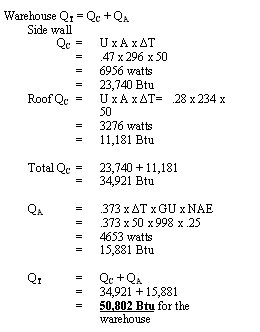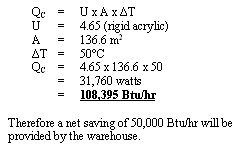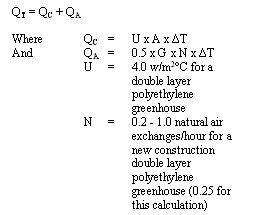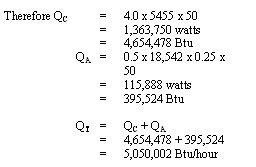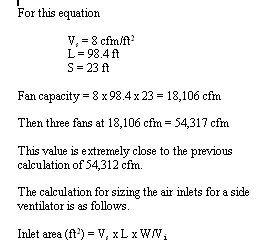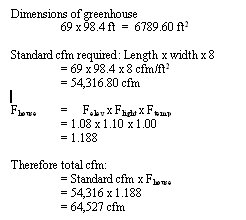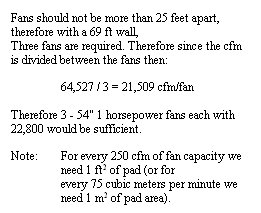This page is archived. We will no longer be updating the information, but it can be used for research or reference purposes.
Greenhouse Heating and Venting
A guideline for determining heating and venting requirements of a greenhouse under Manitoba Conditions
The main purpose of a greenhouse is to provide an environment conducive to plant production on a year-round basis or to extend the growing season. The environment inside a greenhouse is dependant on many factors including the time of year, the amount and duration of natural sunlight, the relative humidity, the size and type of equipment and structure and the type of plants growing in the house.
Since there are many different styles, sizes and configurations of greenhouses in operation and on the market it is impossible to give specific recommendations for each configuration in this publication.
The following should be used as a guide in determining the ventilation and heating requirements of a greenhouse under Manitoba conditions. Since the predominant type of greenhouse used in Manitoba is the double-poly greenhouse, the following recommendations and examples will address this configuration.
The heating requirements of a greenhouse is determined using the following calculations:
Heat Loss Calculations
The following formulas are used to calculate the heat loss from a greenhouse and can be used to approximate the heating system requirements. The greenhouse heating system must have sufficient capacity to maintain optimum growing temperatures inside the greenhouse during periods of extreme low temperatures.
In order to calculate the heat loss from a greenhouse, the following formula is used: QT=QC+QA
Where:
QT = total heat loss
QC= heat loss through conduction
QA= heat loss through natural air exchange
| Heat loss through conduction QC is determined by the equation: | Heat loss through natural air exchange (QA) is determined by the equation: |
|
|
Note: Natural air exchanges will be very low during sub-freezing conditions since the leaks become sealed with frozen condensate. Therefore, for the purposes of these calculations, the number of natural air exchanges for a new construction double polyethylene greenhouse will be set at .25/hour. Low wind velocities or protection from wind also reduces the air exchange rate.
Using the equation for heat loss through conduction requires the following information:
The heat transfer coefficient for the materials used to cover the greenhouse. In your case, the materials are double layer polyethylene and rigid wall acrylic, with heat transfer coefficient of 5.00 Watts/meter2 x D C and 4.65 W/m2D C respectively. (Source: Ontario Ministry of Agriculture, Food and Rural Initiatives, Publication No. 65.)
Exposed surface area in square metres (m2).
Interior temperature of greenhouse (D C).
Outside temperature (average annual minimum - D C).
Side wall area = 2(A x C)
End wall area = 2[1/2(H x B) + (A x B)] x N
Roof area = (D x C) x N
Greenhouse volume = [1/2(B x H x C) + (A x B x C)] x N
Note: N = Number of houses (bays) (see Diagram Figure #1)
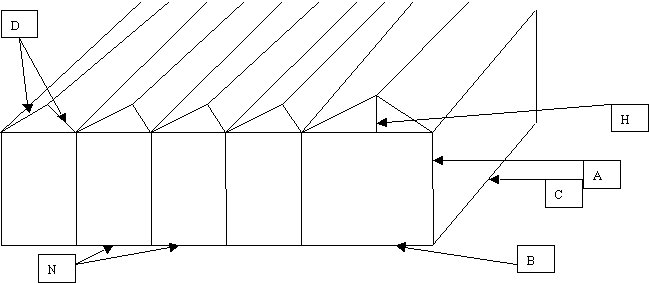
For example: A = 14 feet Side wall area = 2(A x C) To convert to m2 multiply by 0.0929 End wall area = 2[1/2(H x B) + (A xB)] x N Roof area = (D x C) x N Therefore the total surface area of the greenhouse (A) is:
Multiply by 0.0283 to get m3 623,700 ft3 x 0.0283 m3/ft3 = 17,651 m3 Therefore the total greenhouse volume (G) is 17,651 m3 |
The heat loss through conduction can be calculated as follows: Qc = U x A x ∆T Where U = 5.00 W/m2 /0C Note inside temperature 20 0C and outside temperature -30 0C This can then be converted to Btu/hr by multiplying by 3.413 The heat loss through natural air exchange can be calculated as follows: QA = 0.373 x ∆T x G x NAE Final calculation for total heat loss (QT) QT = Qc + QA Therefore the heating system must be able to provide 4,921,710 Btu/hr of heat in order to compensate for potential heat loss at -30 degrees celcius. (Source: University of Guelph - Greenhouse Management) |
|
|
|
Warehouse/Header house: Heat Loss Assumptions
| |
| |
| |
| |
| |
| |
| |
| |
| |
|
Table 1: Please note the following table and the dramatic increase in Btu/hr required as the outside temperature drops below -30°C. | ||||||
Surface Area m2 |
Heat Loss Coefficient W/m2°C |
Exterior Temperature °C |
Change in Temperature °C* |
Natural Air Exchange Heat Loss** |
Conductive Heat Loss |
Total Btu/hr Required to Compensate for Heat Loss |
5455 |
5.00 |
20 |
0 |
0 |
0 |
0 |
5455 |
5.00 |
15 |
5 |
29,506 |
465,448 |
494,954 |
5455 |
5.00 |
10 |
10 |
59,012 |
930,896 |
989,908 |
5455 |
5.00 |
5 |
15 |
88,518 |
1,396,344 |
1,484,862 |
5455 |
5.00 |
0 |
20 |
118,024 |
1,861,792 |
1,979,816 |
5455 |
5.00 |
-5 |
25 |
147,530 |
2,327,239 |
2,474,769 |
5455 |
5.00 |
-10 |
30 |
177,036 |
2,792,687 |
2,969,723 |
5455 |
5.00 |
-15 |
35 |
206,542 |
3,258,135 |
3,464,678 |
5455 |
5.00 |
-20 |
40 |
236,049 |
3,723,583 |
3,959,632 |
5455 |
5.00 |
-25 |
45 |
265,555 |
4,189,031 |
4,454,586 |
5455 |
5.00 |
-30 |
50 |
295,061 |
4,654,479 |
4,949,540 |
5455 |
5.00 |
-35 |
55 |
324,567 |
5,119,927 |
5,444,494 |
5455 |
5.00 |
-40 |
60 |
354,073 |
5,585,375 |
5,939,448 |
5455 |
5.00 |
-45 |
65 |
383,579 |
6,050,822 |
6,434,401 |
5455 |
5.00 |
-50 |
70 |
413,085 |
6,516,270 |
6,929,355 |
| ||||||
Please Note:
The above calculations are based on a freestanding greenhouse structure with all sides exposed to the elements. The calculations do not include heat losses through cracks or holes in the structure, heat loss through the base of the structure, or through inadequately sealed or insulated venting ducts and fans. The calculations also do not take into account the heat savings of a solid structure, such as a headerhouse/workshop attached to one side or end wall or protection from wind by an outside barrier such as a fence or shelterbelt. Since heat loss through radiation is difficult to estimate, it is included in the conductive heat loss calculations.
The calculations for the heat transfer coefficient also provide for a wind velocity of 24 kms/hr (15 miles/hr). As an added precaution, it is often a good idea to add 10% to your total heat loss value to compensate for unexpected heat losses or extreme temperature fluctuations.
The three methods of heat transfer in the greenhouse are convection, conduction and radiation.
Convection is defined as the transfer of heat from an object by the movement of air surrounding the object. There is a layer of air surrounding an object and heat is transferred from the object via the movement of warm air to a cooler location, namely the surrounding air volume.
Convection can be described in a greenhouse situation by the following mechanisms.
Infiltration is the movement of air through openings in the greenhouse structure such as cracks, holes, spaces between glazing materials, around doors, vents, between the foundation and the curtain wall, and other non-designed openings to the outside environment. This air movement can be significant in a glass structure with numerous spaces between glass laps that allow air to pass through relatively unobstructed.
Ventilation is the movement of air in the greenhouse through designed openings in the structure. This air movement is controlled by various mechanisms, which limit the amount of air ventilated. Ventilation of air in a greenhouse can be through natural air movement or forced using fans. Ventilation can serve a number of purposes from reducing the temperature in a greenhouse to venting high humidity air from the greenhouse to reduce disease incidence.
Convective heat loss in a greenhouse can be minimized by providing barriers to air movement such as sealing all holes or cracks in the structure and maintaining equipment in good condition.
Conduction is the transfer of heat from one object to another through direct physical contact. Conduction occurs in a greenhouse through all surfaces exposed to the environment. The amount of conductive heat loss is directly related to the thermal conduction characteristics of the material. A material that conducts heat readily is considered a good conductor like metal, whereas a poor conductor of heat is considered and insulator like Styrofoam. Since metal is considered a good conductor of heat its exposure to the outside environment should be limited in order to reduce conductive heat loss.
This can be accomplished by covering exposed metal surfaces with an insulator such as spray-on foam insulation.
Radiation is a method of heat transfer involving no transfer medium. In practical terms this is the transfer of heat through space in the absence of air. For example, radiation from the sun transfers energy through space that is converted to heat energy when it strikes an object in its path. All objects are capable of absorbing, reflecting and transmitting radiation. The radiation is emitted from objects in the form of longwave (infrared) radiation, which is described as heat. Therefore radiation does not require air (convection) or physical contact of objects (conduction) to be transferred. Heat transfer in a greenhouse occurs through these three methods, conduction, convection and radiation.
In other words the transfer of heat in a greenhouse is through materials of different temperature touching one another, air moving heat energy from one place to another, and the transformation of energy from one wavelength to another. Thermal radiators use the principle of radiation to heat objects in a greenhouse instead of the air, gas furnaces move air via a fan over a hot surface, using convection, to transfer the heat from the object to the air and distribute the air throughout the greenhouse, and hot water pipes in contact with the growing medium or benches transfer heat, using conduction, from the pipe to the growing medium or the bench to the plant. In order to design a heating system for a greenhouse we must first determine the heat loss potential of the structure under the most extreme conditions and match the capacity of the heating system to this heat loss potential.
Hot Water Heat
There are several advantages and disadvantages to hot water heat.
The advantages of hot water and steam heating are evident in a large greenhouse operation due to the central heating provided by the boilers. The amount of water in central hot water heating will take a long time to cool off in case of a boiler failure. This may save the crop from cooling off too quickly before the boiler can be fixed or alternate heating units are brought in.
Hot water or steam heated pipes can be used to circulate under the benches and provide heat to the rooting media. This heats the media and not the air, which is a waste of energy since the media temperature is not consistent with air temperature.
The air temperature in a greenhouse can be at a desirable level, however the media temperature may be a number of degrees cooler putting stress on the plants roots and lowering the production capability of the plant. It would be necessary to raise the air temperature in the greenhouse to a very high level to maintain media temperature at a desirable level. This warm air will also stress the plants by increasing evapotranspiration and dry out the plant, increase water consumption and require high amounts of energy consumption by the heaters.
The bench heating method can also decrease the incidence of root borne pathogens by maintaining warm soil, healthy roots, dry out over watered media and maintain good root growth conditions. Localized heating systems can be at a disadvantage over central hot water or steam heat due to the production of unfavorable temperature gradients throughout the greenhouse. The localized heaters will tend to produce hot air close to the unit and cooler air as the air moves away from the heater. This can place stress on the plants closest to the heater as well as plants at a greater distance.
The cost of a central heating system will be more than installing localized heaters, however over the long run the advantages of the central unit will far outweigh this initial cost. Localized heaters are better suited to the smaller greenhouse operation, which is not operated all year long.
The smaller greenhouse can be adequately heated by localized heaters at far less cost when compared to installing a central hot water or steam heating system. The use of poly tubes to distribute the air more evenly will tend to minimize this temperature fluctuation, however only the air is being heated and not the media directly. Unlike localized heating systems, steam and hot water heat can create favorable air currents in the greenhouse. They can also create unfavorable air currents in the greenhouse if the pipes are not properly place around the greenhouse.
The control of air currents in a greenhouse is very critical to the health of the plant. If the plants along the wall of the greenhouse are exposed to high or low temperature fluctuations over an extended period of time the plants will be subjected to stress and may be stunted or grow in an aberrant manner which will render the plants unsaleable and increase the production costs of the saleable plants in the greenhouse. The proper use of hot water or steam heating pipes under benches and along the outer walls can normalize the air temperature over the entire greenhouse and will eliminate hot or cold spots in the greenhouse.
With proper circulation fans and temperature sensors the grower can maintain the proper temperatures at plant level and produce quality plants throughout the entire greenhouse.
The steam produced by steam heaters can be used to sterilize soil in a greenhouse, however the widespread use of soilless media outweighs this advantage. Hot water and steam heating systems can also be used to heat irrigation water to prevent cold water shock to the plants.
Localized heating units can produce emissions harmful to the greenhouse plants or to the workers in the greenhouse. If the unit heaters are not properly vented to the outside, gases poisonous to plants and humans can be produced by improperly burnt fuels. This possibility is virtually eliminated with central heating systems as the units are usually separate from the rest of the greenhouse, and are therefore vented properly.
Ventilation Requirements
Calculation of ventilation requirements:
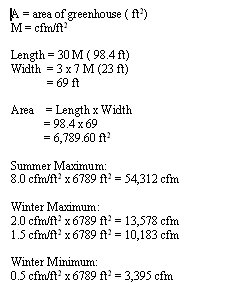
Therefore according to the above calculations the maximum amount of air movement the fans require to achieve summer maximum is 54,312 cfm. The minimum amount of air movement required is 3,395 cfm. The poly-tube ventilation rate would be (winter maximum x 1.10) 13,578 cfm x 1.10 = 14,936 cfm.
From the table 3-4 provided, we could choose a number of fan combinations. Since there are three bays to the proposed greenhouse we should consider a fan for each bay.
Three 42 inch (107 cm) 3/4 horsepower fans, each producing 15,000 cfm at 0.1 inch Static Pressure and three 24 inch (61 cm) 1/4 horsepower fans will each provide 4700 cfm. The summer maximum will be provided by operating all the fans, 3 x 15,000 + 3 x 4700 = 59,100 cfm at once. The winter maximum can be achieved by operating one of the 42-inch fans or all three of the 24-inch fans. The winter minimum can be achieved by operating one of the 24-inch fans producing 4700 cfm.
If a poly tube system is going to be installed than it would need to move a maximum of 14,936 cfm. This can be provided by three 61 cm (24 inch) 1/3 horsepower fans producing 5700 cfm each for a total of 17,100 cfm. Slightly more cfms than required but it is better to have the capacity rather than being under capacity. Using alternate calculation methods, the fans required for this greenhouse are as follows.
Fan capacity in cfm = Vs x L x S
Where
Vs = summer ventilation rate
L = distance between fan and inlet
S = fan spacing in feet
|
|
The length of the side ventilation end wall is 69 ft then the inlet would need to be 3.15 ft high. Depending on the prevailing wind in the region the greenhouse may be oriented in a poor position for endwall ventilation and a side ventilation area is more practical. Then by changing the side ventilation position the wall would be 98.4 ft long, which would change the equation slightly. The opening on the side ventilation wall would only need to be 2.20 ft high.
Evaporative Pad Requirements for Summer Ventilation
|
|
Therefore divide fan capacity by 250
21,509 / 250 = 86 ft2
Since there are 3 fans, 258 ft2 of pad area is required. The pad will cover the entire length of the wall; it will be placed on the sidewall 69 ft. The pad height is calculated by dividing the pad area by the pad length.
258 ft2 / 69 ft = 3.74 ft
So the pad height will be 3.74 ft. high. To calculate the pump capacity we use the value of 7.4 liters of water required per minute per meter of pad length.
Pump capacity = 7.4l/min/meter x 21 m = 155.4 l/min
The tank size is calculated using the value of 18.6 litres of water per meter of pad length.
18.6 l/m x 21 m = 390.6 litres
Note: Evaporative pad cooling systems work on the principle that heat is required to change the state of a material (water), from a liquid state to a gaseous state. The heat used is taken from the ambient air thus reducing the air temperature in the process. This cooling effect works best with hot dry air but loses its effectiveness if the air has a high relative humidity. Areas that have periods of high relative humidity (above 60%) which tend to reduce the effectiveness of the evaporative pad cooling system.
There are a number of energy conservation practices that can be used in this greenhouse in order to conserve energy.
These are:
- The use of energy curtains at night to reduce the amount of heat lost through the roof and sidewalls. This is probably the most effective energy conservation step the greenhouse operator can make as it can save up to 65% of the total heat lost through the greenhouse glazing on the roof and 35% of the heat lost through the side walls. This can constitute an annual saving of 20-40% off the energy bill.
- Insulation of the end walls and gable ends. This will lower the amount of heat lost through these structures without significantly effecting the light gathering capacity of the greenhouse.
- The foundation and perimeter should be insulated to prevent heat loss through the ground. This can account for a significant amount of heat loss in some instances.
- All cracks, holes, slits in the plastic and air spaces between the glazing and other materials need to be sealed to lower the air infiltration rate.
- The vent inlets and fan outlets need to be sealed from leakage and if possible all exposed metal should be insulated since metal is a good heat conductor. This can be accomplished by using weather stripping around the fan and vent shrouds and then spraying insulation over the vent covers to cover the metal.
- Closing the greenhouse during the coldest part of the year will save a considerable amount of energy and will also serve to lower the insect population and in some instances the diseases.
- Lowering the temperature in the greenhouse will also save energy, however lowering the temperature too much will harm the plants and could reduce the productivity of the plants. It is advisable with some plants to lower the heat at night and increase it during the day. Selection for cool climate plants in the coldest part of the season could also lower your heat consumption.
- Proper maintenance of all equipment in the greenhouse will ensure the equipment is operating at peak capacity and efficiency and will conserve energy. This includes all heating mechanisms and electrical equipment such as motors.

